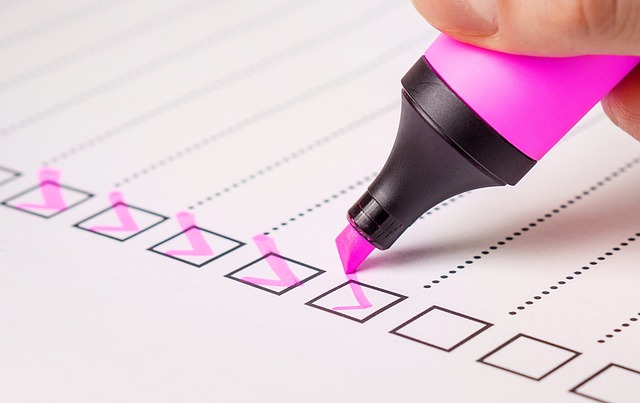Blog Post Checklist: Publish with Success
Have you ever used a blog post checklist?
If you follow an organized structure when researching, writing, and publishing your blog post, you’ll likely meet the goals you have set for creating your post.
To be as successful as possible, it’s important to follow a good checklist. In this article, I’ll share my checklist, which I use to help me get my content listed on page one of Google Search.
This checklist includes what to do before, during, and after writing your blog post.
This blog post checklist was created with you in mind. I want you to be as successful as possible when you write your blog content.
With so many blogs online, it’s important to use every tactic possible to be a successful blogger, especially if you want to make money blogging.
Blog Post Checklist: Before You Write
This part of the blog post checklist will help you determine the best practices to follow before you start writing.
Topic Research: Start by researching your blog topics. These should align with your niche and your audience. It’s important to already have a niche established, and it’s even more important to have a target audience. You’ll know what to write about based on the biggest needs of your niche and audience.
Keyword Research: Once you determine your topic, you need to come up with a keyword. The keyword should align with what you will write about. Research the keyword using an SEO tool like SEM Rush or Uber Suggest. You want the keyword to have a high search volume and a low keyword competition score.
Outline: Next, you want to create an outline for your blog post. This should start with a title. Then, include sections and sub-sections of what you will be writing about. This provides an organized unform of topics you will be covering. Writing an outline is one of the best ways to avoid writer’s block.
Topics/Sub-Topics: Within your outline, I recommend to write sub-topics. This is where you should break your main topics down into sub-topics that are related to the main topics. I typically use main topics for sections with headers and sub-topics as the content or secondary section within each main section.
Goals: Every blog post should have goals. It should have a goal for the reader and a goal for you. The goal for the reader should focus on what you want them to get out of the blog. Of course, that should be determined by identifying what they need to get from your content. Your goal should be the CTA, which I’ll cover more about next.
CTA: Every post should have a CTA. A CTA is a call to action. It’s YOUR GOAL on the blog post. A CTA can be anything, but it should be what you want to get out of the reader reading your content. The CTA might be as simple as the reader leaving a comment. You might also have a goal of them subscribing to your mailing list. Some goals might be transactional with the idea of making a sale. You just need to determine this before you write your post.
Data Collection: Finally, before you start writing your post, you need to collect data and research the topics you will be covering. Make sure you find factual information that can be backed up. With all the misinformation in the world today, it is so critical that bloggers ensure accurate and factual information is being included in the blog post.
After you complete the items on your blog post checklist above, you’ll be ready to start writing your content and moving on to the next items below.
Blog Post Checklist: During Writing
The next part of the blog post checklist pertains to the writing process of your blog post.
Value: It’s important to write content that is highly valuable and of the highest quality possible. You need to identify the wants, needs, and pain points of your target audience. If your content doesn’t provide value, it will be a waste of time to post it. Content is only king when it’s high-quality and valuable.
SEO: Try to use SEO (Search Engine Optimization) best practices. Take your keyword and put it in the title, URL, image ALT tag, title, H1, the first sentence in the first paragraph, and a few more times in your content where it makes sense. The keyword should be placed in content smoothly as if it’s a part of the content. Only use a keyword once, and don’t overplace it, or you could be penalized for it by search engines.
Sentence Auditing: Make sure every sentence you put in your blog post either provides some kind of value or helps to lead up to providing value. Long-form blog content is the best kind of content, but fluff and filler content isn’t the way to do it. Don’t write to just make a long blog post, write to provide as much value as you can fit into a post.
Visuals: Include visuals in your blog posts. Use relative images that are visually appealing and small in size so they load fast. You should also embed videos into your posts, but make sure they focus on certain parts of your blog rather than the whole thing; otherwise, you might lose readers.
Take Time: Try to take some time when creating your blog content. Don’t rush it. The only way your content will be the best possible is if you take your time and write it carefully. If you rush it, you might not be able to include all your points. Eventually, you’ll be able to write your content faster. Still, until then, you need to focus on creating the best content possible by giving yourself plenty of time to write it.
Title: Your title is important. It’s very important. It’s the first thing people will see, and if it doesn’t interest them, they might not decide to read the content. You need to spend some time writing the best title you can. Write something that is going to grab the attention of those reading it. Add value and wording to your title that is powerful enough to make them want to see more.
Introduction: Make sure your introduction is also eye-catching. You need to hook your readers in. Your first few sentences (along with your title) will determine whether or not people will keep reading the rest of your blog post or not. But it doesn’t stop there. Make sure you ensure every sentence provides value and answers to your audience’s needs and pain points.
Sharing: Make sure you include information, buttons, or some kind of prompt on your blog post that recommends people to follow your social media pages. If you have social media in connection with your blog, you should ask people to follow them in each blog you write.
The best practices in the blog post checklist above will help you publish the best content possible.
Blog Post Checklist: After Writing
The following blog post checklist pertains to best practices after you’ve written your initial blog post.
Editing: After you write your blog post, you need to edit and proofread it. I suggest using a grammar editing program such as Grammarly to edit your post. While your content doesn’t need to be perfect, it should be clear of the most noticeable spelling and grammar mistakes. Try to proofread your content before you publish it, too. You can catch a lot of issues that way.
SEO Auditing: Audit your SEO strategies. If you’re using WordPress as your blogging software, you can use an addon like Yoast SEO to check your SEO efforts. Auditing will help you determine if you hit all the right points for SEO. Just don’t feel like you need to be perfect on the number of times you use a keyword. It really doesn’t have to be used but a few times in the main content.
Links: Go through your blog post and add links to it. Add a combination of internal and external links. Make sure all the links are directly relevant to the content you’ve written about. Don’t put an external link in that has untrustworthy content. Make sure the anchor text you turn into a link is descriptive and not generic (like “click here”) or anything like that.
Readability: Audit your content for readability. Yoast has readability built into it. You can also get this feature with most grammar editing services that you can use. Make sure that your content is easy to read. It’s often suggested to write content in a way that makes it easy to read and understand by elementary school children.
Scanning: Make your content scannable. This means that you should use structure like headings, bulleted lists, numbered lists, bold text, whitespace, and shorter sentences and paragraphs. The whole idea of this strategy is to ensure that your content is mobile-friendly. Most blog readers scan through content rather than read big blocks of text. So, it’s important to write for mobile first because that will often be the majority of your audience.
Publish: Now it’s time to publish your blog post. Take one more time to look it over quickly and then publish it. I like to be able to schedule my content to publish ahead of time. I try to create enough content to schedule so that I can remain ahead of the game.
Share: After your content is published and live, you should share it with others. Share it on your personal and blog-related social media accounts, your mailing list, and online communities. Don’t spam it, but share it with everyone.
Comments: Watch for comments on your blog post. Try to reply to every comment you get. Reply with reasonable thoughts. Thank them for leaving a comment. Add something more to the comment that encourages deeper discussion, such as questions and observations. The idea is to keep the discussion going in the comments sections.
After you complete the blog post checklist above, you’ll be ready for blogging success.
Final Thoughts About this Blog Post Checklist
It’s important to follow a blog post checklist like the one detailed above. It will help you keep your blog on target and set you up for success.
At the end of the day, though, writing the best content possible should be your ultimate goal for achieving as much success as possible.
Thank you for reading my blog post today. If you enjoyed reading it, please share it with other bloggers that you know. You can also buy me a coffee for writing it if you want to.
Join my free online community, Blogging Collective. We discuss all things blogging and I need help growing it. It’s free, and there are no ads.
About the Author
Shawn Gossman has created content, blogged, ran online communities, and shared a passion for digital marketing for over twenty years. Shawn believes the best way to help content creators, businesses, brands, and marketers is to give away more than you sell. The same advice is recommended for the readers who follow this blog. Shawn also offers various services for extra help in content creation and blogging.
Grow your online brand with exclusive tips from me sent right to your inbox!


